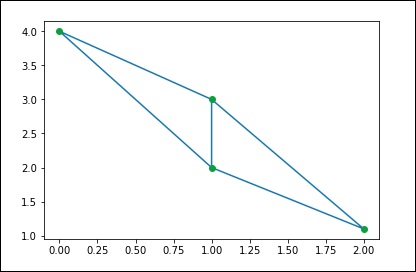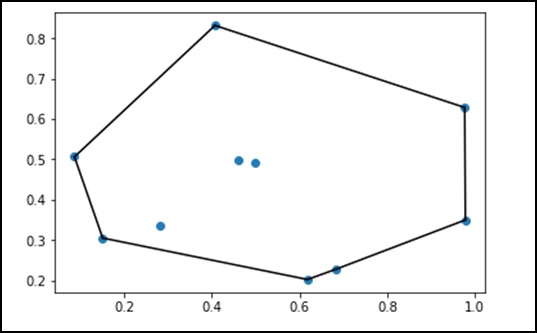SciPy Spatial
SciPy Spatial
The scipy.spatial package computes triangles, Voronoi diagrams, and convexity plots for a set of points by leveraging the Qhull library. It also includes a KDTree implementation for nearest neighbor queries and tools for distance calculations using various metrics.
Delaunay Triangulation Computation
Let’s understand what Delaunay triangulations are and how they are used in SciPy.
What are Delaunay Triangulations
In mathematics and computational geometry, for a set of discrete points P on a plane, a Delaunay triangulation is a triangulation DT(P) such that no point in P lies within the circumference of any triangle in DT(P).
We can compute the same result using SciPy. Let’s consider the following example.
from scipy.spatial import Delaunay
points = np.array([[0, 4], [2, 1.1], [1, 3], [1, 2]])
tri = Delaunay(points)
import matplotlib.pyplot as plt
plt.triplot(points[:,0], points[:,1], tri.simplices.copy())
plt.plot(points[:,0], points[:,1], 'o')
plt.show()
The above program will produce the following output.

Coplanar Points
Let’s understand what coplanar points are and how they are used in SciPy.
What are Coplanar Points
Coplanar points are three or more points that lie in the same plane. Recall that a plane is a flat surface that extends endlessly in all directions. In math textbooks, it is often shown as a quadrilateral.
Let’s see how to find this point using SciPy. Let’s consider the following example.
from scipy.spatial import Delaunay
points = np.array([[0, 0], [0, 1], [1, 0], [1, 1], [1, 1]])
tri = Delaunay(points)
print tri.coplanar
The above program will produce the following output.
array([[4, 0, 3]], dtype = int32)
This means that point 4 is near triangle 0 and vertex 3, but is not included in the triangle.
Convex Polyhedrons
Let’s understand what convex polyhedrons are and how they are used in SciPy.
What is a Convex Polyhedron?
In mathematics, the convex hull or convex envelope of a set of points X in the Euclidean plane or Euclidean space (or more generally, in affine space over the real numbers) is the smallest convex set that contains X.
Let’s consider the following example to understand this in more detail.
from scipy.spatial import ConvexHull
points = np.random.rand(10, 2) # 30 random points in 2-D
hull = ConvexHull(points)
import matplotlib.pyplot as plt
plt.plot(points[:,0], points[:,1], 'o')
for simplex in hull.simplices:
plt.plot(points[simplex,0], points[simplex,1], 'k-')
plt.show()
The above program will produce the following output.
